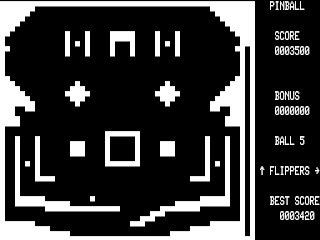We continue our exploration of the Fall 1981 Acorn Software lineup with a look at page 5, where we find three more TRS-80 simulations of traditional games created by Basketball programmer John Allen:
I question the wisdom of promoting Astroball as superior to Pinball, still available for sale just below it. And the pricing seems a little loopy, as the tape version of Pinball is cheaper than Astroball on the same medium, while the disk version of Astroball is cheaper than Pinball. I was able to find all three of these games in the online archives -- apparently these were more successful than some of Acorn's other products.
Astroball is actually pretty good, although the ball physics are clunky and unconvincing, feeling more like a vertically-oriented pachinko game than a sloping pinball table, and the flippers are oddly mapped to the right-arrow and up-arrow keys. And I never found the "table nudge" control, if one exists. But the action moves along at a good clip, and there are enough items on the board with a few innovative moving obstacles to keep the ball from becoming too predictable. The TRS-80's chunky pixels make it hard to tell where the ball actually is in still shots -- here, it's just to the upper right of the plus-shaped bumper on the left.
And yes, Pinball is worse. It's almost the same program, actually -- just a bit slower and clunkier, more static and repetitive, with a couple of ball-swallowing side ramps that are hard to avoid. The physics issues are different -- a good pull on the launch plunger can cause the ball to float merrily across the top of the playfield with no gravity effects coming into play at all, until it suddenly decides to drop like a stone. It seems clear that Astroball might also have been called Pinball 2.0.
Tenpins (a.k.a. John's Ten Pin in-game) is a bowling game, obviously, and has 3-D Graphics in the sense that the ball appears as a larger or smaller roughly spherical block of pixels, in three chunky steps based on distance from the foreground. I was able to get the game to boot up, but was not able to initially figure out the keyboard commands for aiming the ball -- all I could do was throw the ball back up the gutter. I finally realized that hitting the right arrow moves the ball to the right, and hitting the up arrow moves the ball to the left, apparently reusing the awkward keyboard routine from Mr. Allen's pinball games.
If the program truly "automatically senses the skill of each player," as stated in the description, I wasn't able to recognize any such behavior. Basically, we just position the ball, and when we throw it by hitting the space bar, it wipes out anything in its path, including the lane markers and the lines delineating the gutter boundaries. The animation of the ball hitting the pins is unconvincing -- they do not get knocked out of the way, but instead get tipped over and appear to be trampled into undifferentiated mush, as though they were made out of papier mache weighted with oatmeal.
So far, I'm not too impressed with Acorn's offerings. But hope springs eternal, as we move on to Page 6 in our next installment.
Sunday, March 13, 2011
Subscribe to:
Post Comments (Atom)










I think the TRS-80s had a weird layout for the arrow keys, with up/down on the left edge, and left-right set to the right of the number keys. For the pinball game, Allen was probably trying to mimick the side mounted flipper buttons on a real table.
ReplyDeleteNo idea why he would have stuck with that on the bowling game. He wrote the Basketball game from the previous entry in this series, and those keys were also selected to be as near an edge as possible... maybe he thought that would be more accessable than WASD/IJKL?
That's an interesting theory -- I don't know the exact chronology of which games came first, but if the first pinball game was the first one coded, that would make perfect sense. Good eye!
ReplyDelete